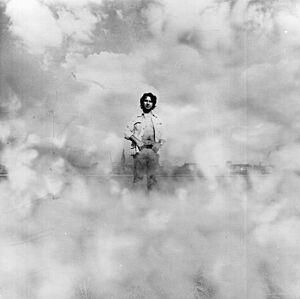Gotthard Graubner facts for kids
Quick facts for kids
Gotthard Graubner
|
|
|---|---|
 |
|
| Born | 13 June 1930 Erlbach, Germany
|
| Died | 24 May 2013 (aged 82) Neuss, Germany
|
| Known for | Painter |
Gotthard Graubner (born June 13, 1930 – died May 24, 2013) was a famous German painter. He was born in a place called Erlbach, in Germany.
Graubner studied art at several academies in Germany. Later, he became a professor, teaching painting to other students. One of his artworks, Black Skin, was even shown on a special BBC TV show in 1980. He spent his later years living and working near Düsseldorf, where he passed away just before his 83rd birthday.
Contents
Early Life and Art Studies
Gotthard Graubner was born in 1930 in Erlbach, Germany. He started studying art at the Academy of Arts in Berlin from 1947 to 1948. After that, he went to the Academy of Arts in Dresden. There, he learned from a teacher named Wilhelm Rudolph.
When his teacher had to leave the Dresden academy, Graubner supported him. Because of this, Graubner also had to leave the school. In 1954, he moved away from East Germany.
Studying in Düsseldorf
From 1954 to 1959, Graubner studied painting at the Düsseldorf Academy of Arts. He first learned from Otto Pankok. Later, he became a special student of Georg Meistermann. When Meistermann left the academy, Graubner became one of the first students of Karl Otto Götz.
In 1959, Graubner finished his studies at the academy. Around this time, he met Otto Piene and Heinz Mack. They were the founders of an art group called Zero. For a few years, Graubner also worked as an art teacher in Düsseldorf.
Becoming a Professor
In 1965, Graubner started teaching at the Academy of Fine Arts in Hamburg. By 1969, he became a full Professor of Painting there. Then, from 1976 to 1992, he was a professor at the Academy of Fine Arts in Düsseldorf. He taught many students during his time there.
In 1988, the German President asked Graubner to create two artworks. He also made a special "cushion picture" for the German Parliament building. In 1996, he joined the Saxon Academy of Arts in Dresden.
After he retired, Graubner continued to live and work in Düsseldorf. His last years were spent on an island called Museum Insel Hombroich, near Düsseldorf.
Graubner's Unique Art Style
Graubner's art is special because of his ideas about color. He started creating his own style around 1959. Before that, he used color in small amounts, mostly on the edges of his paintings. But from 1955, he began trying new ways to use color. He started using lots of color instead of focusing on shapes.
Around 1960, he made flat paintings with blurry layers of color. He put many thin layers of paint on top of each other. This made the paintings look like they had a deep, unclear space, similar to the works of artist Mark Rothko.
Cushion Pictures and Fog Spaces
In the 1960s, Graubner started attaching colored cushions to his paintings. He also used a special fabric called Perlon. He did this to make the colors look like they were coming out of the painting. These artworks were shown in a gallery in Düsseldorf.
Between 1968 and 1972, he created works he called "Nebelräume," which means "Fog Spaces."
Graubner never let popular art trends tell him how to paint. He developed his own way of using color. For him, color was the most important part of his art. His paintings might look like one solid color at first. But if you look closely, you can see many different colors. His works seem to "breathe" and move, stirring your imagination.
His "color-space bodies" are like objects where color and shape work together. Graubner saw his art as a mix between famous painters like Caspar David Friedrich and J. M. W. Turner. He also felt connected to old masters like Titian and Paul Cézanne.
Experts say Graubner's special way of using color, light, and space is unique. He presents color to viewers as if it were a landscape. He pays close attention to details, using different shades and balancing warm and cool colors. His artworks don't have a specific topic. Instead, they are about exploring color and using many shades of the same color.
Exhibitions of Graubner's Art
Gotthard Graubner's paintings have been shown in many places. In 1975, there was a big exhibition of his work in Hamburg. In 1977, an exhibition called "Gotthard Graubner: Color Spaces, Color Bodies, Works on Paper" was held in Düsseldorf.
In the 1980s, his art was shown in London at exhibitions like "A New Spirit in Painting." In 1982, Graubner took part in the Venice Biennale, a very important art show. His paintings were also shown in many other cities across Germany.
Later, in 2000, his drawings were displayed in Dresden. His other works traveled to Istanbul, Barcelona, and Ankara. In 2005, his paintings and watercolors were shown in art museums in China.
Famous Artworks by Graubner
Some of Graubner's well-known works include his Kissenbilder (Cushion Pictures) from the 1960s. He also created Erster Nebelraum – Hommage à Caspar David Friedrich (First Fog Space – Homage to Caspar David Friedrich) in 1968. He made more Fog Spaces between 1969 and 1971, and again from 2006 to 2007.
In 1988, he was asked to create two large cushion pictures for the Schloss Bellevue in Berlin. This building is the official residence of the German President.
Awards and Recognition
Gotthard Graubner received several awards for his art. In 1987, he won the August Macke Prize. The next year, in 1988, he was given the North German Art Prize. In 2001, he received the Otto Ritschl Prize. This award honors artists who have dedicated their lives to painting with color.
See also
 In Spanish: Gotthard Graubner para niños
In Spanish: Gotthard Graubner para niños
- List of German painters

